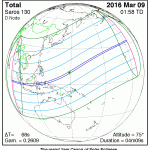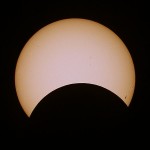On March 9, 2016 a total solar eclipse will sweep across Indonesia and into the central Pacific. This will be an late afternoon eclipse, with maximum occurring just before sunset at around 17:37 HST (5:37pm HST).

Note, you might be confused by some references that state the eclipse occurs on March 9th. It does occur on the 9th! For our islands greatest eclipse occurs around 03:30 on March 9th universal time. If we convert to Hawaiian Standard Time this will be the 17:30 (5:30pm) on the afternoon of March 8th. You must remember that universal time is ten hours ahead of Hawaiian Standard Time.

A deep partial can be very interesting. Even people not expecting the eclipse may notice a dimming of the Sun and an odd, subdued nature to the sunlight. Even a quick glimpse of the Sun will reveal that half of the disk is covered. Eclipse glasses or a welding filter will provide a nice image of a partially eclipsed Sun. Tree leaves and other makeshift pinhole cameras will show crescent images of the Sun on the ground. For best viewing a small telescope with a solar filter, or a pinhole camera will allow excellent images of the eclipse. My standard eclipse viewing setup is a 76mm refractor with a Baader film solar filter. I assembled this gear for the 2012 Venus transit and it has seen several eclipses since.
| Solar Eclipse Data for March 8th, 2016
|
||||
|---|---|---|---|---|
| Mag | Begin | Max | End | |
| Hilo | 55% | 16:37 | 17:37 | 18:32 |
| Honolulu | 63% | 16:33 | 17:36 | 18:33 |
| Lihue | 67% | 16:31 | 17:35 | 18:33 |
| Kahului | 60% | 16:35 | 17:37 | 18:33 |
| Kona | 56% | 16:36 | 17:37 | 18:32 |
| Mauna Kea | 56% | 16:37 | 17:37 | 18:32 |
| Midway Is | 97% | 16:04 | 17:20 | 18:29 |
| All times HST | ||||
| Source: EclipseWise Interactive Map | ||||
As you can see the magnitude of the eclipse increases notably the closer you are (further north in the main islands) to the path of totality. The timing does not vary by nearly as much, with maximum eclipse occurring around 17:36 for the islands.
If you would like to see precise information for your location, or for someplace other than the islands, just use the interactive map and click on your location for data.

There are no further solar eclipses near the Hawaiian islands until 2031 and 2035, the path of totality for both of which pass well south of the main islands. There is also an annular eclipse in 2024, for which the center line also passes well south of the islands.

